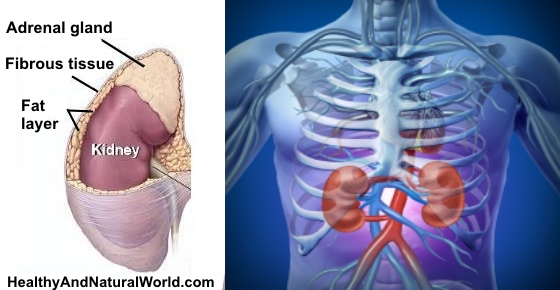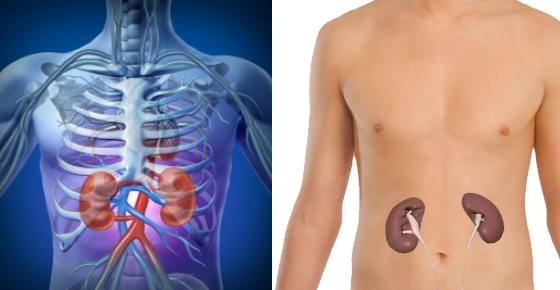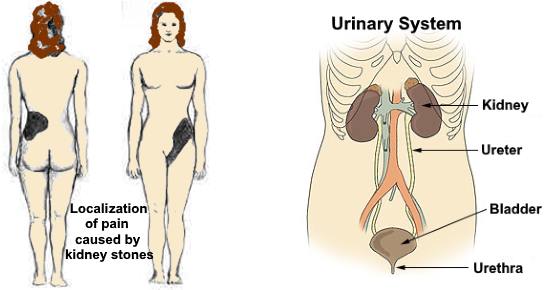Where Your Kidneys are Located & Where Kidney Pain is Felt

Your kidneys are bean-shaped organs that are located in the middle of your back against the back muscles, with one on either side of your spine. Your kidneys provide a vital function for your body to filter blood and produce urine. Pain in your upper abdomen or back and sides is also called flank pain or kidney pain. Flank pain can sometimes be an indication of a kidney infection or urinary tract infection. Kidney stones are also a common cause of kidney pain that is felt in the middle back.
In some cases of kidney pain, there are a few simple steps to alleviate the pain in your back. However, in general, you should see a doctor for any type of kidney or flank pain to rule out any serious condition that causes the kidney pain. This includes acute, sharp pain that occurs suddenly in one or the other side of your middle back.
In this article, you will find out all you need to know about the causes of flank pain that are associated with your kidneys. This will help you tell the difference between general back pain and pain that comes from your kidneys.
The Location of the Kidneys
Your kidneys are two organs about the size of your fist that are shaped like a bean. According to Dr. Charles Patrick Davis on MedicineNet, your kidneys are located just below your rib cage in the back of your abdomen under your liver. Because the largest part of your liver is on the right side of your abdomen, your right kidney sits a little lower than your left kidney.1
Therefore, most infections or issues with your kidney health cause flank or middle back pain. Usually, kidney pain is different from back pain because is it constant and doesn’t get better if you move position or massage the area.
Where are your kidneys located in your body – diagram
The function of the kidneys
Your kidneys are closely connected with your urinary tract and filter out waste from your blood and get rid of excess fluid. Urine from the kidneys flows down the urinary tract and into your bladder. You then get rid of this waste product when you pee.
According to the National Institute of Diabetes and Digestive and Kidney Diseases, your kidneys also help keep your blood healthy.2 Some ways your kidneys do this is by:
- Keeping a balance of electrolytes in your blood.
- Regulating blood pressure.
- Producing a hormone called erythropoietin (EPO) which is required for making red blood cells.
- Removing waste from your blood.
Kidney Pain Location and Sensation
Most people tend to associate pain in the area between the ribs and hips as either digestive problems or muscular back pain. However, kidney pain isn’t always felt in the same place as the kidney’s location.
Dr. Charles Patrick Davis on MedicineNet explains that renal or flank pain can be felt anywhere between the lowest rib and the buttocks. The pain may also radiate to the groin or abdominal area. Depending on the underlying cause of the kidney pain, you may feel the pain in just the left or right side of your back. However, sometimes kidney pain affects both sides of the back.3
Kidney pain vs back pain
Sometimes it can be difficult to distinguish between kidney pain and back pain. Some muscular problems in the back or other diseases can mimic kidney pain. Dr. Davis goes on to explain that pain that comes from your kidneys is usually accompanied by other symptoms. For example, you may notice changes in your urination or you may have a fever.3
Usually, back pain is distinguished from kidney pain because it may get better or worse when moving the back muscles. Unlike kidney stone pain which comes on in sharp, painful waves, back pain is more constant and connected with movement.
In general, flank or kidney pain is usually higher in the back just under the ribs and the pain sensation is deeper. Back pain that is muscular is usually in the lower back.
General Symptoms of Kidney Pain
Apart from causing pain in your middle back, abdomen, or groin area, kidney pain will often have other symptoms. According to doctors from the Mayo Clinic, some of these could be:5, 6
- Fever and chills
- Nausea and vomiting
- Increase in urination frequency
- Burning sensation when urinating
- Urine that has a strong odor or is cloudy
- Strong need to urinate and sometimes only urinating small amounts
Causes of Kidney Pain
Most kidney or flank pain is felt around the location of the kidneys. However, as you will see, depending on the cause of kidney pain, kidney disease and infections can cause pain sensations elsewhere in your body.
Kidney stones
Kidney stones are one of the most common reasons for severe sharp, flank pain that may radiate to your groin area. One of the first signs that you have kidney stones is a severe pain below the ribs on your side and back. According to the Mayo Clinic, the pain can then spread to the lower abdomen and you could experience nausea, vomiting, pain when urinating, and fever.
Kidney stones form when minerals and salts form in the kidney into tiny stone-like substances. Although tiny, the pain they can cause in your kidneys and urinary tract can be excruciating.
According to doctors from the Mayo Clinic, it is only when the mineral deposits in your kidneys move that they cause pain. One of the first signs is an agonizing pain in your flank, below your ribs. Depending on where the stone moves, the pain from the kidneys may come and go and radiate to the lower abdomen and groin.6 Some of the other symptoms of kidney pain are passing cloudy or pink urine, painful urination, and having to pee more than usual.
There are a number of ways to treat kidney stones naturally. For example, you can drink apple cider vinegar for kidney stones to help dissolve the mineral buildup in your kidneys. You should drink a glass of water with 1 or 2 teaspoons of cider vinegar frequently through the day. The acidic nature of apple cider vinegar and the increase in your fluid intake helps to dissolve and flush out the kidney stones.
Urinary tract infection (UTI)
Because your kidneys in your middle back are connected to your urinary system, a urinary tract infection can also cause kidney pain.
Dr. Siamak Nabili on eMedicineHealth says that bacteria can enter the urinary tract and cause an infection. Bacteria can reach the kidneys via the urinary system and cause a kidney infection resulting in a dull pain on the side or in your lower back.7, 8 Some other symptoms of a UTI are a fever (however, sometimes you could experience chills without a fever), bubbles in your urine, or discolored urine.
Dr. Adam Husney on WebMD says that a urine test showing the presence of nitrites in your urine is a strong indicator that bacteria is the cause of the infection. Your doctor may also check for leukocytes in your urine which can also indicate a bacterial urinary tract infection.
You can prevent a urinary tract infection from causing a kidney infection by treating the early UTI symptoms.
Kidney infection (Pyelonephritis)
Any kind of infection in your kidney will cause dull flank pain as well as other symptoms. Apart from a UTI that can lead to kidney infection and kidney pain, Dr. Minesh Khatri on WebMD says that a blockage in the urinary tract, prostate infection, or not emptying your bladder completely can all cause kidney infections and pain.9
The infection in our kidneys may also cause symptoms like fatigue, blood in your urine, lack of appetite, and lower back pain.
If you have any signs of a kidney infection, it’s important to seek medical help immediately. Dr. Khatri says that, if left untreated, kidney infections can lead to life-threatening problems.10
Kidney injury
A blow to your middle back could injure your kidneys and cause kidney pain because they stop working properly. However, Dr. Gregory Thompson on WebMD says that kidney injury can also happen due to long-term use of certain medicines, ingesting poisons, or a serious drop in blood flow to the kidneys.11
Dr. Thompson explains that as well as causing flank pain, kidney injuries can result in passing very little urine, swelling in your legs, loss of appetite, nausea and vomiting.
Blood clots
Blood clots can be very serious and a clot in the vein that drains blood from the kidney can cause lower back pain.
Dr. Charles Silberberg on MedlinePlus says that blood clots in the kidneys (renal vein thrombosis) can be caused by an aortic aneurysm, pregnancy, or severe trauma to your back or abdomen.12
Kidney cysts
One of the reasons why you can have kidney pain is because a cyst has formed in your kidneys. Sometimes, small sacs of fluid form in the kidney and usually don’t cause any harm.
Dr. Melinda Ratini on WebMD says that in most cases a kidney cyst doesn’t cause any symptoms. However, if the cyst becomes larger and presses on other organs, it can cause pain in your upper abdomen, flank, or side.
In some cases, a kidney cyst can become infected which will result in pain that could radiate to your lower abdomen or groin. If you have flank pain and signs of an infection, you should see your doctor immediately.
Pregnancy and kidney pain
Pregnancy can sometimes cause kidney pain. Being pregnant puts you at a greater risk of developing a urinary tract infection or blood clots all which can cause a sensation of pain in your middle back.
Dr. Melissa Conrad Stöppler on MedicineNet, says that during pregnancy the uterus becomes enlarged and the urine flows slower. You could even experience vesicoureteral reflux where urine flows back up the urinary tract. This means that it is easier for bacteria to enter the urinary tract and spread the infection to the kidneys.14
Kidney disease
In its early stages, kidney disease doesn’t cause any symptoms. It is usually only when the disease is advanced people realize they have serious issues with their kidneys. One of the early warning signs of kidney disease is lower back pain.
According to the National Kidney Foundation, pain below the rib cage or on your sides could be coming from your kidneys. This may be accompanied by a change in urination so that you either urinate less or more often, and your pee may be foamy and smell bad. A urine test usually looks for protein in your urine which can also show that the kidneys aren’t functioning properly.15
Make sure to avoid these common habits that can damage your kidneys.
Diabetes
If you have diabetes, you may experience flank pain because of kidney disease. Dr. Anne Poinier on WebMD says that diabetes is one of the main causes of kidney disease. Dr. Poinier recommends managing your diabetes symptoms properly to lower your risk of kidney disease.16
If you have diabetes, you can follow a diet that doesn’t put a strain on your kidneys and can help prevent kidney disease and the pain that accompanies it. This includes reducing salt intake and protein. Regular exercise and not smoking or drinking will help keep your kidneys working better.
Kidney cancer
In some cases, constant pain coming from your kidneys and your middle back could be a symptom of kidney cancer. However, there will usually be more cancer warning signs, not just kidney pain.
The American Cancer Society says that along with the low back pain, you may have loss of appetite, blood in the urine, a lump on the side or lower back, unexplained weight loss, and a constant fever. However, doctors say that these symptoms can also be caused by other kidney problems. So, you should visit your doctor to have a full check up.17
When to See a Doctor for Kidney Pain
Kidney pain that you feel in your middle back or that radiates to your abdomen or groin is usually an indicator of a serious health condition.
According to Dr. Charles Patrick Davis, you should visit your doctor promptly if you suspect kidney pain. Some of the warning signs of kidney disease or problems are:
- Sharp flank pain that comes on suddenly
- A dull, constant one-sided pain in your back or side
- Blood in your urine
- Frequent and/or painful urination
- High blood pressure
- Swelling around your feet and hands
Read these related articles:
- Early Signs of Kidney Disease & How to Protect Your Kidneys
- 15 Common Habits That Can Damage Your Kidneys
- What Your Urine Can Tell You about Your Health
Article Sources


